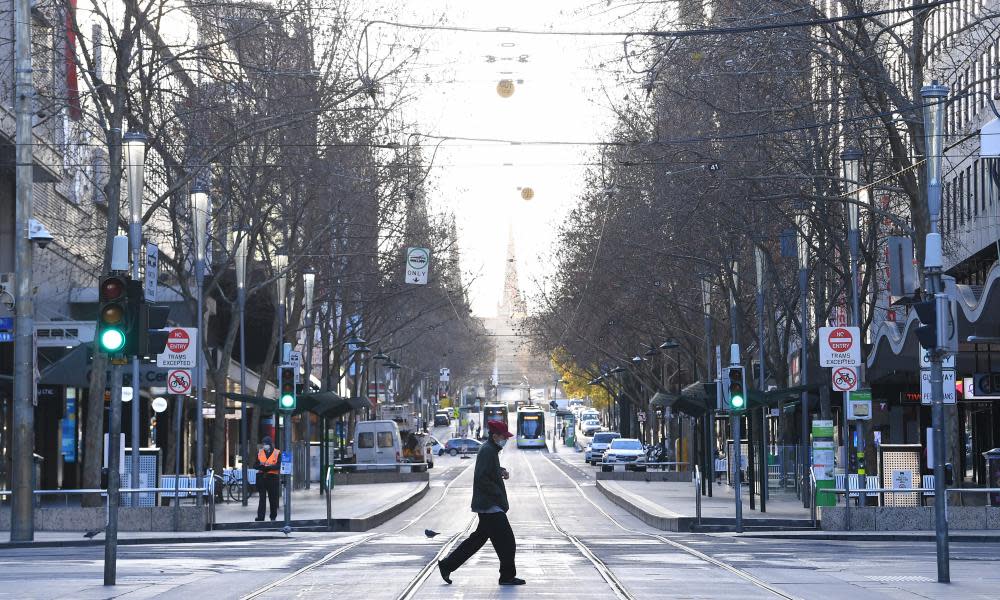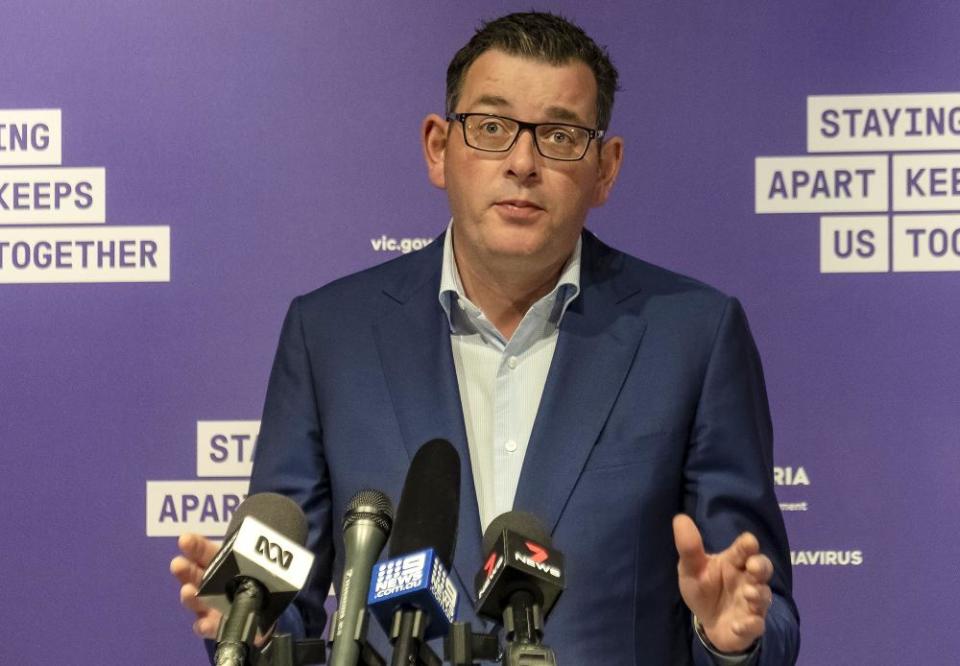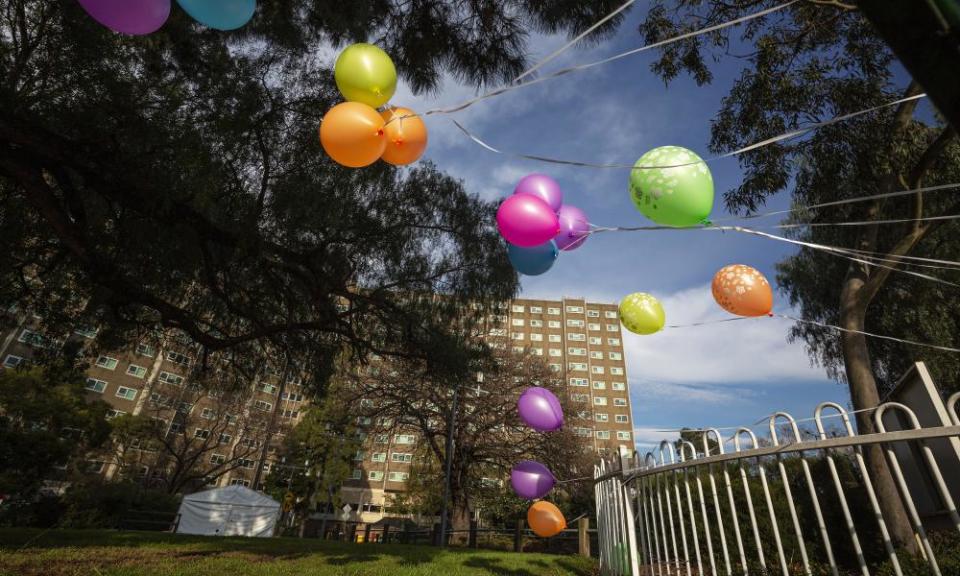'It has to work': the reins are tightening on a Covid-stricken Victoria, but how did we get here?

Wednesday marks 28 days since stage three restrictions were reintroduced across greater Melbourne and the Mitchell Shire.
In that time, the number of positive coronavirus cases recorded in Victoria has quadrupled to 12,335, and the number of deaths linked to Covid-19 has increased by 125, to a total of 147.
And the number of cases attributed to community transmission – dubbed “mystery cases” – has increased almost five-fold to 2,159. Meaning, in large part, we don’t know how or where the virus is spreading.
The virus is now threaded throughout Melbourne, spreading unnoticed through asymptomatic or very mildly symptomatic people and defying the team of more than 2,000 contact tracers who are trying to track it back.
Related: Pandemic leave is just Victoria's hardship payments rebadged, Labor says
Most deaths are connected to the devastating outbreaks in the aged care sector, as are 1,186 of the new cases – or about a sixth of all active cases. The rest are attributed to outbreaks in other workplaces, particularly insecure, highly casualised workplaces like the meat industry. Even more worryingly, more than one in four cases appear to be marked as untraced community transmission: mystery cases with no known link to a current outbreak.
Despite the toughest restrictions in Australia – a statement which was true even back in early June when Victoria was beginning to open up – the outbreak is still not under control.
Even on 1 June, when Victoria announced an easing of restrictions, there were mystery cases listed on the daily update. Those community clusters were not publicly linked back to failures in hotel quarantine until 30 June, almost five weeks after the first staff member at the Rydges on Swanston Street tested positive.
Now the reins are even tighter. As of Sunday, Melbourne is under stage four lockdown until 13 September and regional areas are heading back to stage three.

A curfew has been introduced in the city from 8pm to 5am, the first in Melbourne’s history. A state of disaster has been declared, giving the police minister the power to suspend any legislation.
From this week, entire industries will be shut down and an additional 250,000 are expected to be unable to work. Industries that are allowed to continue, like abattoir workers, will be working with reduced staff “dressed as if they are a healthcare worker” in full PPE.
But still, the only financial support to stay home is a $1,500 hardship payment – the federal government has declined to offer full paid pandemic leave.
Police and uniformed army officers have teamed up to question people who are out jogging, to make sure they haven’t left their home radius, and to knock on the doors of everyone who has tested positive to Covid-19. From Tuesday, people found to not be at home will face a $5,000 fine.
Asked about those tough new penalties, Andrews said: “I’m not so much about looking back.”
But to understand how we got here, that’s what we have to do.
Six weeks and 10,518 cases ago
Let’s start just over six weeks ago, on 20 June. Victoria recorded 25 new cases, bringing the total to 1,817 – more than 10,000 cases fewer than today. Just 110 cases were active, and to date some 200 cases had been attributed to community transmission.
“Today, our case numbers have hit the highest they’ve been in more than two months,” Andrews said in a statement that day.
The state was due to ease restrictions on 22 June. Instead they tightened again. The number of guests people could have in their homes reduced back down to five, just three weeks after being raised to 20. Outdoor gatherings were once again limited to 10. The source for the outbreak had not yet been named, but it was spreading at family gatherings, Andrews said.

Ten days later, on 30 June, Victoria recorded 64 new cases and Andrews placed 10 postcodes in the northern and western parts of the city into lockdown. The intervening fortnight had seen the state’s coronavirus tally increase by 342 cases. At a press conference that Tuesday, Andrews said a “significant number, and potentially more, of the outbreaks in the north of the city are attributable via genomic sequencing to staff members in hotel quarantine breaching well-known and well understood infection control protocols”.
Andrews ordered a judicial inquiry, headed by former family court judge Jennifer Coate, into the operation of the hotel quarantine system. Ever since, he has declined to answer questions about the hotel quarantine process, saying that was a matter for Coate.
Related: 'We are all breaking down': Melbourne towers residents feel abandoned for a second time
Later in the day on 30 June, the deputy national chief health officer, Prof Michael Kidd, told reporters in Canberra that implementing stage three restrictions on 10 postcodes was “the north-west Tasmanian model being implemented in an urban setting in a large city”.
That was in reference to the outbreak at two regional Tasmanian hospitals in April, which led to 5,000 people being self-isolated and the northwest of the state being locked down.
But the Tasmanian government published an interim report on the source of the outbreak and failures in infection control procedures about two weeks after that lockdown was announced. The Victorian hotel quarantine inquiry will hear its first witness on Thursday 6 August, and report to government by 25 September – more than a week after the six-week stage four lockdown is due to end.
Then, on 4 July, the Victorian government locked down nine public housing towers on the back of 12 positive cases, confining 3,000 people to their small apartments in the first ever “hard lockdown” in the country. Eight of the towers remained under hard lockdown for five days, the ninth for longer. The towers are now are under the same restrictions as the rest of Melbourne and the number of positive cases linked to the cluster has grown to 310, but residents say they are “breaking down”.

Four weeks and 9,393 cases ago
On 8 July, the stage three lockdown was enforced city-wide. Victoria had just recorded a daily total of 134 new cases, the third day in a row with more than 100 new cases. The lockdown was to be in force for six weeks, with regional Victoria – excepting the Mitchell Shire – exempt.
In early July, figures in the low 100s were a disaster. Now they would look like success. The mean daily increase for the 28 days since is 335.
On 10 July, Andrews issued a statement saying people in greater Melbourne and the Mitchell Shire are “requested” to wear face masks or facial coverings when they leave their home. On 22 July, that rule became mandatory, and on 30 July it was expanded statewide.
On 14 July, the total number of cases in Australia topped 10,000. By 31 July, Victoria’s total topped 10,000 – the day after the state recorded the single worst day of the pandemic so far, with 723 new cases and 13 deaths in 24 hours. Ten of those deaths were linked to aged care.

When he addressed the media at his daily press conference on 28 July, Andrews said the case numbers were being driven by outbreaks in aged care, and that some stories of what had occurred in aged care homes struck down by the virus were “completely unacceptable”. He would not, he said, let his mother live in some of these places, and announced that non-urgent elective surgery would be suspended to allow public and private hospital nurses to move in.
But hospital workers were also affected. As of this week there were more than 700 active cases among healthcare workers and little information about whether the virus was spreading in hospitals. On 27 July, four cases were linked to the neonatal intensive care unit in the Royal Children’s Hospital, including one tiny patient.
Three days and 778 cases ago
Stage four lockdown was announced on the afternoon of 2 August and came into effect in greater Melbourne at 6pm. The city’s first ever curfew began two hours later. Business shutdowns were announced the next day, with businesses deemed non-essential shut from midnight on Wednesday and essential businesses, like construction and meatworks, to scale back from midnight on Friday.
Year 12 students, who had just over two weeks back in their classrooms, said goodbye to high school and were returned to remote learning for the rest of their academic year.

The second wave is nothing like the first. In the first wave of the pandemic, Victoria’s highest daily total was 111 on 28 March. It was the peak of the wave: Australia recorded 469 cases in one day and a cumulative total of 3,633 cases since the first case was recorded in Australia on 25 January.
New Zealand, which has been held up as the example of the success of a stage four lockdown, has recorded a total of 1,567 cases, mostly in returned travellers in March and early April, with minimal community transmission.
In contrast, Victoria alone recorded 3,286 cases in the past week.
Related: Minister refuses to name Victoria aged care homes battling Covid-19 due to 'reputational' fears
When he announced the stage four restrictions on Sunday, Andrews said that it was a choice between a slow economic death from six months of stage three restrictions, or six weeks of harsher measures in the hope that would bring numbers back down to a manageable level. Andrews told reporters on Monday that the next step of restrictions, if stage four doesn’t work, is “inconceivable”.
“There is no stage five,” he said. “It has to work.”


